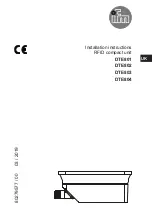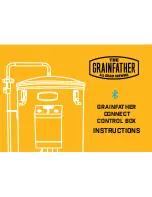
Rev. 4/26/2018
CH-200, MANUAL
Copyright 2018 Vestil Manufacturing Co.
Page
5
of
7
Using the Lifter:
Review all warnings in “Hazards of Improper Use”
on p. 3 before using the lifter for the first time. Only trained,
designated persons should use the lifter. “Designated person” means someone selected by his or her employer,
or by a representative of the employer, as competent to use the lifter. Trainees under the direct supervision of a
designated person may also use the device.
NOTE:
This device is classified as a “Load supporting lifter” in the American national standard ASME B30.20,
which is a type of “structural and mechanical lifting device” (“SMLD”). The standard includes use,
maintenance, and inspection recommendations for SMLD’s. The instructions in this manual are meant to
supplement
recommendations in the standard. You must acquire a copy of the standard.
Step 1: Make sure that the block surfaces are clean before using
the lifter. Also make sure that the lifting bale is secured all the
way forward in the slot (as shown).
Step 2: Turn the hand wheel counterclockwise until the clamp
pad is fully retracted.
Step 3: Attach the lifter to your hoist. The hoist chain, or rope,
must be equipped with a latching hook in normal condition.
Step 4: Move the hoist and lifter into position next to the block of
material. Bring the lower jaw of the block clamp into contact with
the bottom of the block. Make sure that the block rests against
the vertical wall of the lower jaw.
Step 5: Turn the hand wheel clockwise until the clamp pad
contacts the top of the block. Make the connection as solid as
possible by hand (~20in·lb).
The hoist chain/cable should be straight up-and-down when
the lifter is connected to a block. Deflection from vertical will
cause the load to swing when it is lifted off of the ground.
Swinging loads can cause serious injury. Swinging might also
affect the clamp’s grasp on a block.
Step 6: Confirm that the lifter can control the load. Grasp the
lifter and slowly raise the load just a few inches above the
ground. Watch the block to make sure that it does not move
within the clamp. If
any
movement occurs, lower the block to the
floor. Reapply the clamp. Do not use the lifter to move a block
that exceeds 200 pounds.
Step 7: When the block is securely clamped, grasp the lifter and raise the load to an ergonomic height, e.g. mid-
chest level. Whenever moving a load:
a. NEVER lift material over yourself or other people.
b. Keep your hands away from the block while raising, lowering, and moving it.
c. Always grasp the lifter and walk to the side at about arm’s length. Make sure that your clothing, feet, and all
other parts of your body stay out of contact with the load.
d. If you are using a motorized trolley, DO NOT push or pull on the lifter. Hold onto the lifter ONLY to stabilize
it during travel.
Step 8: Make sure that the lifter is not swinging or rotating. Slowly lower the block. When the block rests on the
floor/ground, release the clamp by turning the hand wheel counterclockwise. Lift the clamp pad off of the block.
Inspections & Maintenance:
Before using the lifter for the first time, create a written record that describes each component--the lifter body,
clamp mechanism (hand wheel, clamp pad, clamp support arm), lifting bale, rubber matting on the lower jaw, and
all hardware. This written record establishes “normal condition”. When conducting future inspections, compare
those observations to the written record to determine whether a component needs to be repaired or replaced.
Regular inspections and maintenance are necessary for the lifter to remain in normal condition. Perform all
inspections recommended in ASME B30.20 at least as frequently as recommended in the standard. In addition to
the B30.20 inspections, perform the inspections described on p. 5-6. Correct all problems discovered during an
inspection. Do not use the lifter if it cannot be restored to normal condition.
Before Each Lift
Visually inspect the lifter for damage such as bends, severe wear, warps, cracks, or other deformations of the
lifter body, lifting bale, or block clamping mechanism (wheel, clamp pad, clamp supporting arm).
(Continued on p. 6)
Lifting bale
Supporting arm
Vertical
wall of
lower jaw
Clamp
pad
Hand
wheel
Clamp
screw
Slot
Lifter
frame

























